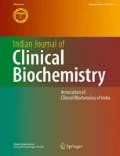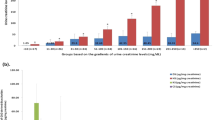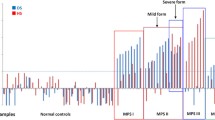Abstract
Mucopolysaccharidoses, a group of inherited disorders are associated with defects in glycosaminoglycan metabolism. Thus, assessment of urinary glycosaminoglycan is used as a screening test for mucopolysaccharidoses. The detection methods range from qualitative spot tests to quantification using metachromatic dyes. In our laboratory we optimized a spectrophotometric quantitative method using a metachromatic dye, dimethylmethylene blue. Heparan sulfate was used for quantification. The glycosaminoglycan–dye complex showed a marked shift in color with increase in concentration. The color complex was quantified at 520 nm. The method was linear from 10–89 mg/L. An age matched normal range was obtained in 177 healthy individuals, grouped in 8 different age groups from neonates to adults. Urinary glycosaminoglycan concentration varied distinctly amongst the study population wherein the lowest range in healthy neonates was more than 3 times the upper limit of healthy adults. Urine samples from 10 patients with mucopolysaccharidoses were also included in the study for clinical validation. The method qualified both analytical and clinical validation and was found to be simple, robust and ideal to be offered as a screening test for mucopplysaccharidoses in a routine clinical chemistry laboratory.


Similar content being viewed by others
References
Berg J, Tymoczko J, Stryer L. Biochemistry. 5th ed. New York: W.H.Freeman and Company; 2002.
Willen M, Sorrell M, Lekan C, Davis B, Caplan A. Patterns of glycosaminoglycans/proteoglycans immunostaining in human skin during aging. Cleveland: The Society for Investigative Dermatology, Inc.; 1991. p. 968–74.
Coutinho M, Lacerda L, Alves S. Glycosaminoglycan storage disorders: a review. Biochem Res Int. 2012;. doi:10.1155/2012/471325.
Meikle P, Fiezt M, Hopwood J. Diagnosis of lysosomal storage disorders: current techniques and future directions. Expert Rev Mol Diagn. 2004;4(5):677–91.
Manley G, Williams u. Urinary excretion of glycosaminoglycans in the various forms of gargoylism. J Clin Pathol. 1969;22:67–75.
de Jong J, Wevers R, Laarakkers C, Poorthuls B. Dimethylmethylene blue-based spectrometry of glycosaminoglycans in untreated urine: a rapid screening procedure for mucopolysaccharidoses. Clin Chem. 1989;35(7):1472–7.
Pennock C. A review and selection of simple laboratory methods used for the study of glycosaminoglycan excretion and the diagnosis of the mucopolysacharidoses. J Clin Pathol. 1976;29:111–23.
Whitley C, Ridnour M, Draper K, Dutton C, Neglia J. Diagnostic test for mucopolysaccharidosis. I. Direct method for quantifying excessive urinary glycosaminoglycan excretion. Clin Chem. 1989;35(3):374–9.
Soldin S, Brungara C, Hicks J. Pediatric reference ranges. 3rd ed. Washington, DC: AACC Press; 1999.
Clinical and Laboratory Standards Institute. Defining, estabilishing, and verifying reference intervals in the clinical laboraotry; Approved Guideline. 3rd ed. CLSI document C28-A3. Wayne, PA: Clinical and Laboratory Standards Institute; 2008.
Beckman Coulter. Synchron system(s). Chemistry information sheet. Creatinine REF A40920.
Panin G, Nala S, Dall’Amico R, Chlandetti L, Zachello F, Catassi C, et al. Simple spectrophotometric quantification of urinary excretion of glycosaminoglycan sulfates. Clin Chem. 1986;32(11):2073–6.
Carroll G. Spectrophotometric measurement of proteoglycans in osteoarthritic synovial fluid. Ann Rheumatic Dis. 1987;46:375–9.
de Jong J, Wevers R, Liebrand-van Sambeek R. Measuring urinary glycosminoglycans in the presence of protein: an improved screening procedure for mucopolysaccharidoses based on dimethylmethylene blue. Clin Chem. 1992;38(6):803–7.
Acknowledgments
We acknowledge support extended by the National Health & Education society for the funding, healthy volunteers for the study sample. Dr. Dhanashri Shetty for reviewing the manuscript and Dr. Vrajesh Udani for referring MPS patients for validation.
Author information
Authors and Affiliations
Corresponding author
Rights and permissions
About this article
Cite this article
Dave, M.B., Chawla, P.K., Dherai, A.J. et al. Urinary Glycosaminoglycan Estimation as a Routine Clinical Service. Ind J Clin Biochem 30, 293–297 (2015). https://doi.org/10.1007/s12291-014-0456-y
Received:
Accepted:
Published:
Issue Date:
DOI: https://doi.org/10.1007/s12291-014-0456-y




